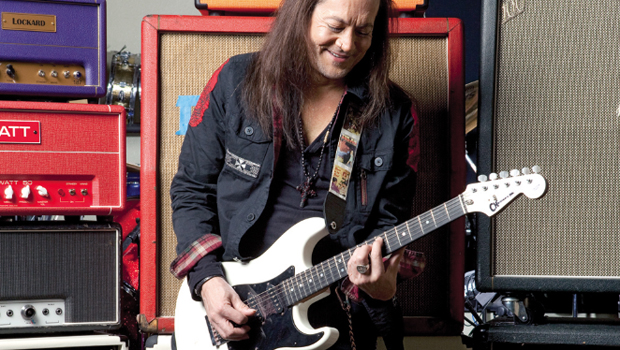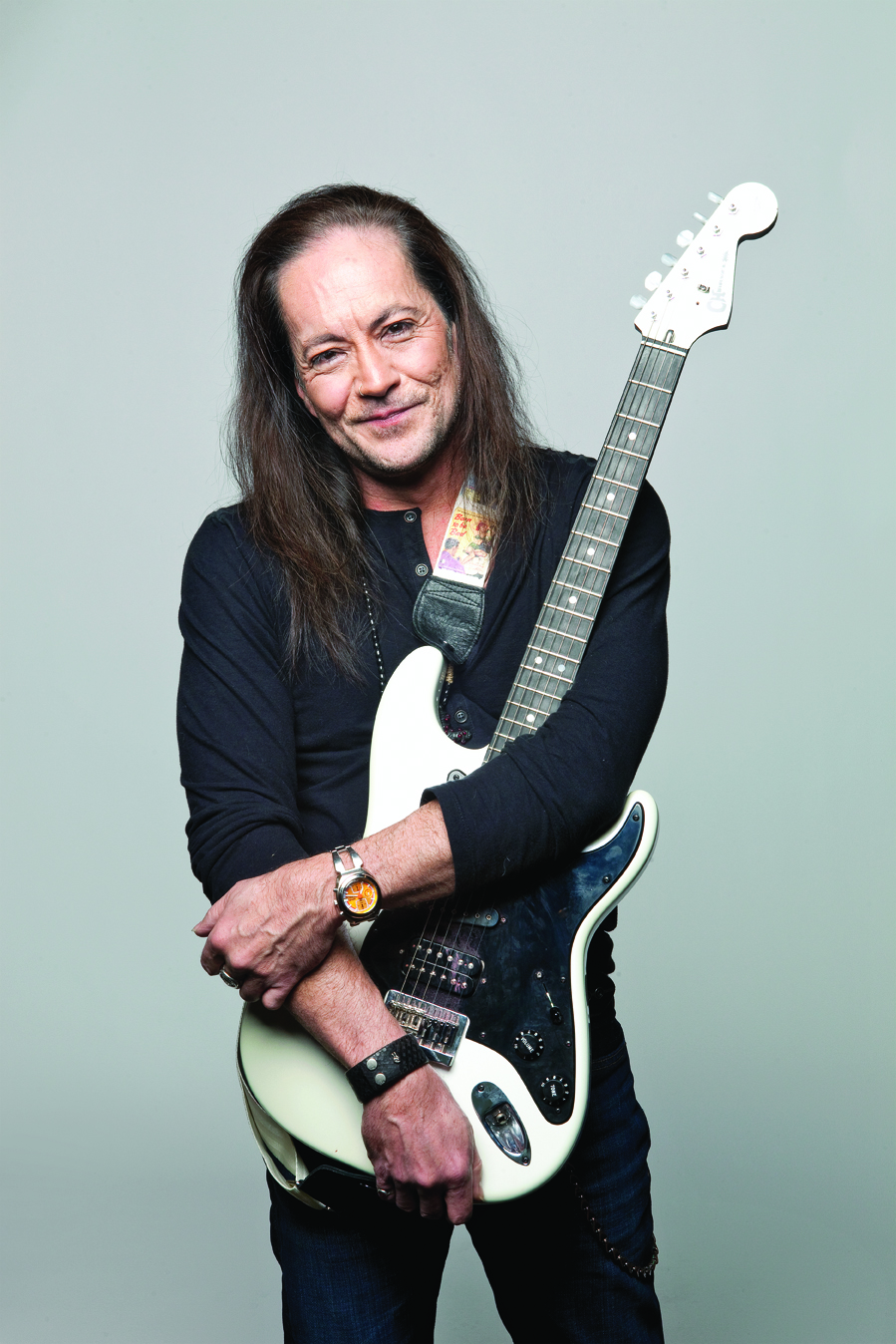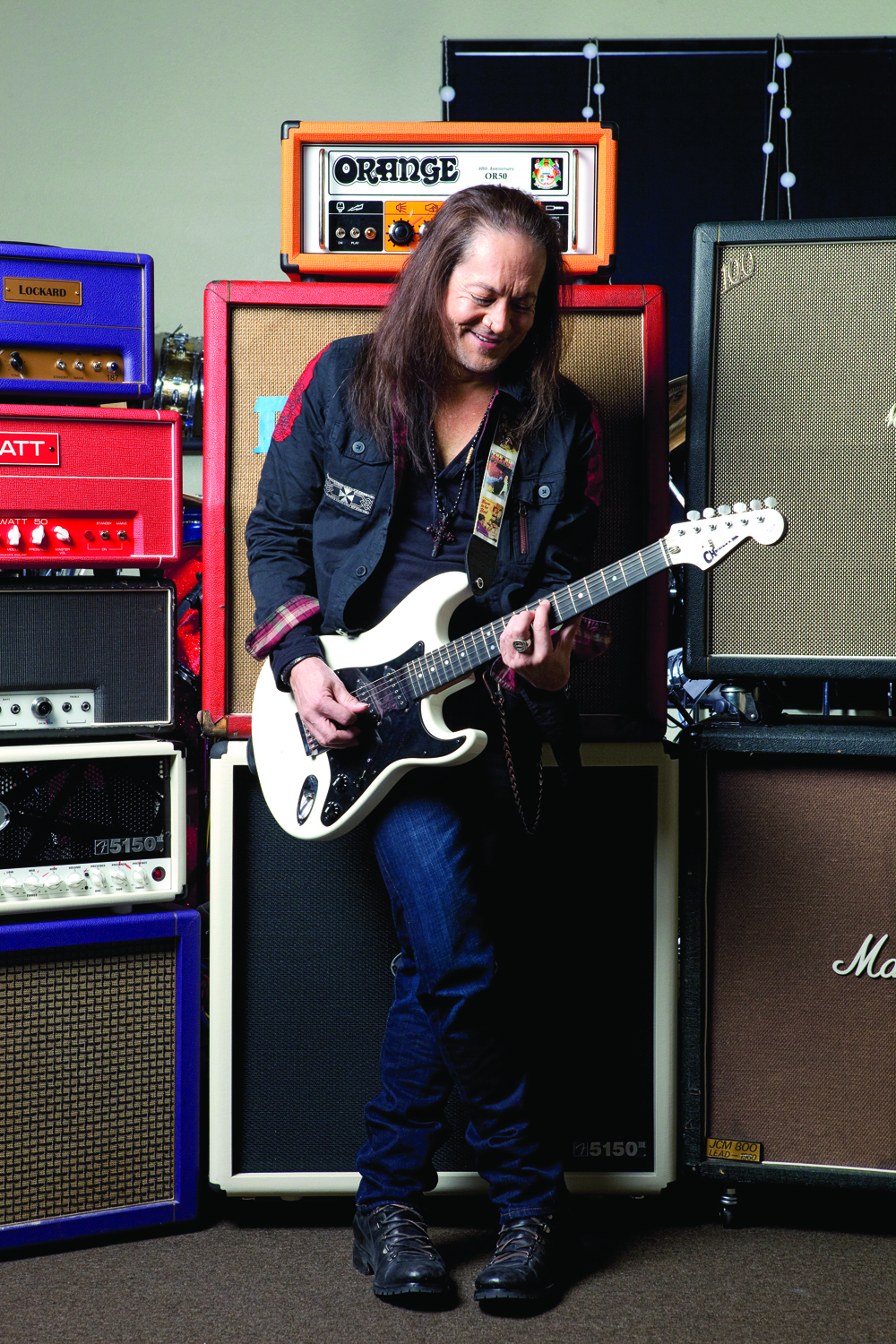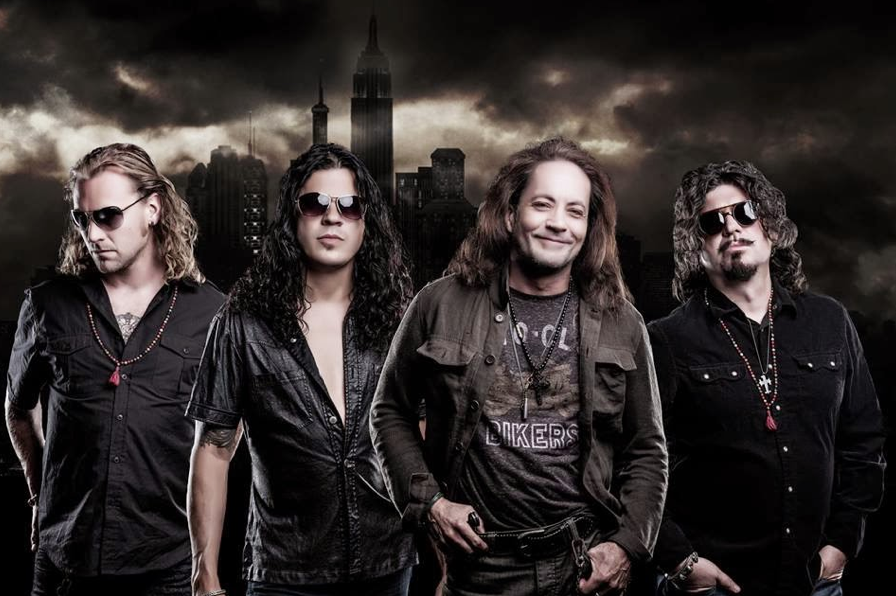Interview: Jake E. Lee Is Back in Action with Red Dragon Cartel, a Band that Shows Off More Than His Considerable Guitar Chops

“For a while, it was pretty uncool to be me,” Jake E. Lee admits, speaking to Guitar World from a Las Vegas recording studio late one December evening.
It’s something of an unexpected statement, but what is even more surprising is the fact that Lee is saying anything at all.
Back in the Eighties and early Nineties, when he was slaying arena stages with Ozzy Osbourne and his own group, Badlands, the San Diego–raised ax man was a bona fide guitar god, with a beautifully liquid and limber playing style that, much like his serpentine stage moves, seemed to flow from him effortlessly.
And yet, save for a few low-key recordings, it’s been more than 20 years since most rock and metal fans have heard anything new from the guitarist.
Until now. Earlier this year, after decades of relative inactivity, the 56-year-old Lee announced the creation of a new band, Red Dragon Cartel. The group, which he formed with friend and Beggars & Thieves bassist Ronnie Mancuso (and which also features singer D.J. Smith and drummer Jonas Fairley), recently released its self-titled debut album.
It’s a hard-hitting, 10-song collection that features guest appearances from artists like Cheap Trick’s Robin Zander, In This Moment’s Maria Brink and former Iron Maiden vocalist Paul Di’Anno. It also highlights Lee’s inimitable guitar playing and, perhaps most importantly to him, showcases his talents as a composer. “I was never too comfortable being seen as just a shred guy,” he says. “I was always more interested in the song.”
And yet, Lee first came to national attention as the man tapped to fill Randy Rhoads’ incredibly large shoes in Ozzy Osbourne’s band. He appeared on 1983’s Bark at the Moon and 1986’s The Ultimate Sin, two albums that established him as one of the preeminent shredders of his day.
Then, following a sudden and unexpected dismissal from the Osbourne camp, he re-emerged in 1988 with Badlands, a heavy blues-rock combo that also featured former Black Sabbath singer Ray Gillen and future Kiss drummer Eric Singer, and emphasized Lee’s songwriting chops as much as his guitar. The group released two strong records, 1989’s Badlands and 1991’s Voodoo Highway, but soon disbanded amidst internal tensions.
With grunge and alternative rock in full bloom at the time, and Lee feeling that he was becoming pigeonholed as an Eighties-rock relic, the guitarist decided to head underground. “I figured, Okay, I’ve had a nice run. I’ll keep making music but I’ll just make it for myself,” he says. “I thought I’d bow out gracefully.”
Now, with Red Dragon Cartel, Jake E. Lee is ready to throw his hat back in the rock-guitar ring.
GUITAR WORLD: How did Red Dragon Cartel come together?
It was real casual. About two years ago, Ron [Mancuso] just approached me about doing something. I hadn’t done anything in a while, and I can’t say I really had any plans to. But he had been talking with [producer] Kevin Churko [Ozzy Osbourne, Five Finger Death Punch], who has a studio here in Vegas, and they both thought it’d be interesting to see if I was interested in playing. I had ideas that I’d saved up for the last 15 years or so, and Ron and I started to go through them. Since we didn’t have a band, per se, and it was just the two of us writing and recording, we figured we’d just do like a Slash or Santana thing and reach out to different guys to see if they’d want to sing on different songs.
You mentioned that some of the riffs on the new album date back more than a decade. Did you have a lot of material stockpiled?
Oh, yeah. I had hundreds and hundreds of little WAV files in a folder on my computer. Some of them were fully fleshed-out songs, and others were just, like, five-second riffs. The one with Maria [Brink], “Big Mouth,” that was probably one of the first things I ever recorded onto a computer, back in ’96 or ’97. The opening guitar thing you hear on the record, that’s the actual original track I recorded back then. So it’s 16, 17 years old. And the most recent thing I wrote was what became the first song on the album, “Deceived.” That was probably from a few months ago. All the others fell somewhere in between.
So you’ve been recording all these years, but without any explicit intention to release anything to the public. What was the goal?
I was just stockpiling ideas. I still had a desire to make music, but at a certain point, particularly in the mid Nineties, I didn’t see any interest from people. I’d kind of outlived my shelf life, especially since I was a part of—and I hate saying it—the hair-metal thing. So there weren’t a lot of interesting opportunities coming my way. It was always people from that one genre wanting me to make more music like that.
Or, because I also had Badlands, it was blues-rock guys that wanted to form blues-rock bands. But I’d already done those two things and I was looking to do something else, something more musically exotic, maybe. But I wasn’t cool anymore, and I was shot down a lot.
From what you’re saying, it sounds like if the musical climate had been different in the Nineties you would have stayed in the game.
I would have. If I had had an opportunity to make something fresh and exciting, I certainly would have stayed. But I didn’t want to just rehash Badlands or Ozzy.
During your years out of the spotlight, you went through periods where you didn’t pick up a guitar at all.
Yes. Especially in the mid Nineties, when I got heavily into computer stuff. I would tear computers apart, put them back together. I used to do that with cars, too. And because of that I started looking into music software and getting involved in that. So I was still writing music, but not necessarily on guitar. And there were long stretches where I didn’t play. At one point, I probably went a year without picking up my guitar. But I was always creating music in one form or another. It’s always been my first love in life. It’s still what I was doing all that time.
Because you haven’t released much music over the last few decades, you’re encased in amber for a lot of fans, so to speak. With this new record, they might be expecting to hear Jake E. Lee shredding like it’s 1986.
Well, that shred thing was me in Ozzy. I don’t think it was me so much in Badlands. I remember when we were recording that first Badlands record, our A&R guy would come into the studio, hear the songs and then say, “You need to do a guitar solo. You need to have your own version of ‘Eruption.’ ” And I would be like, “Um, no, I really don’t.”
The focus in Badlands was the music and the songs. I was hoping to shed that whole shredder thing at that time. But, that said, after all these years of having “disappeared,” every once in a while I’ll Google my name and I’ll see a lot of people that like to talk about some of the flashier things I used to do: the over-the-fretboard thumb thing, the whammy sounds from bending the neck. People seem to focus on those things a lot.
For better or worse, those tricks helped to establish you as a guitar hero to a certain segment of music fan. Is that something you were comfortable with?
Not completely. But Ozzy did place a lot of emphasis on it. He said, “Okay, when we do a concert, you’re gonna have to have a guitar solo.” And I hated the whole idea of it. So that’s when I came up with some of the flashier stuff. And really, toward the end of my solo spot I was just making a bunch of noise. Because I didn’t want to just stand there and shred in front of a bunch of people. If you watch some of the old live footage, half of my solo spot is me rolling around on the floor and making noises with my guitar.
Were those days with Ozzy happy times for you?
I wouldn’t have missed it for anything. It was very exciting. I went from being just another guitar player in L.A. to playing at the US Festival in front of hundreds of thousands of people and traveling the world. The only thing that would have made it better is if I’d been able to do it all with a group of friends, like everybody else I knew.
The guys in Mötley Crüe, in Ratt—they all went up the ladder together, whereas I felt like I was in a band with a bunch of old coots that had been doing it for a long time. [laughs] When I’d get excited about being in a new country—shit, when I’d get excited about just being in an airplane—they’d all be like, “Yeah, yeah…” I didn’t really have anybody to share it with. But it’s still a part of my life I’ll always look back on fondly.
You mention Ratt—a lot of people probably don’t know that you were a member of the band in their early days.
Yeah. They were originally from down in San Diego, when they were Mickey Ratt. After they moved to L.A. they shortened the name. I think they ran into some problems with Disney. Then I moved up to L.A. about a year later and ended up joining them.
Ratt quickly became one of the hot bands in the Sunset Strip scene.
Sure. At the time Mötley Crüe was still the big band in town. But we were starting to headline places like the Whisky [a Go Go], all the big clubs.
So why did you quit?
There were a bunch of reasons. I felt that [lead singer Stephen] Pearcy was taking on the rock star attitude a little bit more than I cared for. He’d be drunk onstage, he’d announce a song that we’d already played three songs earlier, that kind of thing. And then there was the fact that [late guitarist] Robbin [Crosby] got into the band. Because when we started it was just me on guitar.
And then Robbin moved up to L.A. maybe six months after I did, and he didn’t know anybody else, so he’d come to all the Ratt shows and hang out. Then he started campaigning hard to be in the band. Eventually I said, “Okay, okay. But just play what I tell you to play. I don’t want you to get in the way. I like the one-guitar thing.” And he said, “No problem.”
But once he was in, things changed completely, of course. It was, “So when do I get to solo?” And I was like, “Dude, I’ll tell you what. You can take a solo whenever you can do one better than me.” Now, that was kind of mean, but it upset me when he changed his whole tune. So, basically, Robbin was getting on my nerves because I didn’t want to be in a two-guitar band, and Pearcy was pissing me off because he was drunk all the time. At some point I just said, “Fuck it, I’m done.”
From there, you did a short stint with Rough Cutt and then hooked up with Ronnie James Dio. You played with him right as he was launching his solo career after leaving Black Sabbath.
I met Ronnie because his wife, Wendy Dio, was managing Rough Cutt. So Ronnie would come out to all the shows and eventually he asked me to play with him. It was an early formation of the Dio band. We would jam in his garage—me on guitar, Vinnie [Appice] on drums and Ronnie on bass. And I remember there was no P.A., and Ronnie would stand in the room and you could hear him sing, even without a mic. And I had a 100-watt Marshall going! But I think the only song I played with him that eventually made it to his first record was “Holy Diver.” I remember working on that a little bit.
After Dio, you went to Ozzy, where, even though there were a few guitarists that preceded you in his band—Bernie Torme, Brad Gillis, and even George Lynch for a minute—you were seen as the true successor to Randy Rhoads. Had you been a fan?
I thought Randy was great. Also, I loved Sabbath. I grew up on them. And when they fired Ozzy, me and everyone else thought that was it for him. So when he put out Blizzard of Ozz with Randy, I was blown away. I couldn’t believe it. He came back with a vengeance.
Did you find any of Randy’s guitar parts particularly challenging to play?
I can’t think of anything in particular that I found challenging. Then again, I was only given, like, a week to learn everything. So, really, it was all challenging! It was like one big homework assignment.
The details behind your dismissal from Ozzy’s band have always been murky. But generally speaking, it seems that the two of you didn’t click on a personal level.
We definitely were different types of people. And I’m sure that had a lot to do with it. I mean, I don’t know personally what Ozzy’s relationship with Randy was like, but from the outside it looked like they were brothers. Ozzy and I, we never connected on anything more than, “Here’s a song, let’s play it.” We never became friends. We never bonded. We worked well together, but I think maybe at some point Ozzy wanted to get a deeper connection with his guitar player. And he obviously got that with Zakk [Wylde], because they spent a lot of years together.
Were you surprised to be let go?
I was. I didn’t see it coming at all. In fact, it was my roommate, who was my tech at the time, who told me I was out of the band. He came back from the Rainbow one night and he said, “Everybody’s talking about how you just got fired.” So I called up Sharon [Osbourne], and I was like, “I just heard the weirdest rumor.” She said, “Oh, my god. It’s true, it’s true.” I went, “I’m fired?” And she said, “Yes.” My whole world got turned upside down.
That said, when you came back with Badlands, it seemed, at least from the outside, to be a more authentic expression of your musical personality than maybe anything you had done previously.
Well, it was certainly another side of my playing. And I wouldn’t say the stuff I did with Ozzy wasn’t me. I loved metal, I loved Black Sabbath. It was all heartfelt. But I did have certain boundaries there. And after two records with Ozzy, I admit I was starting to feel a little bound in. So Badlands presented me with a whole new musical palate to draw from. I’d always loved blues rock, and this was a chance to play in that style. Badlands wasn’t necessarily what I had always hoped to do, but it opened up a whole other side of my playing that I hadn’t been able to tap into with Ozzy.
Guitar-wise, in those days you were closely associated with the white Charvel that came to be known as Whitey. But in reality that guitar wasn’t a Charvel at all, correct?
That’s right. It was actually a mid-Seventies Strat. And originally it had a tobacco sunburst finish. Back in San Diego I worked at a guitar store, and I picked it out of a dozen Strats they had there. And the thing is, I originally intended to get one with a [whammy] bar. But when I went through all the guitars, the one that didn’t have the tremolo on it was head and shoulders above the rest as far as its tone. So I got that one. Otherwise, I probably would have played a bar through my whole career.
So how did a tobacco-burst Strat become a white Charvel?
By the time I moved up to L.A. my guitar was looking kind of trashed. And the tobacco sunburst thing didn’t really fit in with the Sunset Strip vibe. Looking back on it now, it sounds kind of silly, but the guitar didn’t look cool. Everybody else seemed to have bright, custom guitars. I kind of felt like the poor boy. So for my birthday, my roommate at the time, who worked as a painter in the Charvel shop, offered to take it in and paint it. And while it was in the shop, they also shaved down the headstock and slapped on a Charvel sticker. So that was it. But at least now I felt like I belonged! Even though I was really just an imposter. [laughs]
You also changed the pickups.
Yeah. I would always swap out my pickups in those days. Eventually I settled on a [Seymour Duncan] JB for the bridge humbucker, and the two single-coils were DiMarzio SDS-1s. And for amps, I had two old Marshall 100 watts—a Plexi and an aluminum face. In the studio, I would doubletrack my parts, with the Plexi on one side and the aluminum face on the other. And then I had my Boss OD-1 [OverDrive], the two-knob version. I would just turn down the distortion and crank the volume on it.
What gear did you use on Red Dragon Cartel?
The bulk of the rhythms were done with my ’68 SG Standard, and for leads I used either my ’63 SG Junior or my ’58 Les Paul TV Special. For amps, I had a new EVH [5150] head that belonged to Kevin [Churko] and a ’68 plexi 50-watt of Ron’s. On some things, like “Feeder,” I played this little eight-watt Lockard, which is a great-sounding amp. Super saturated. And then I also had a ’69 Laney Supergroup 100-watt—the classic Sabbath amp—which I used on “Deceived” and “War Machine.”
Are you planning to do extensive touring around Red Dragon Cartel?
We’re doing a few shows, and we have some festivals lined up in Europe, where they still like old guys like me. [laughs] Japan looks promising, too. But I don’t know about America. They’re not as fond of somebody my age. But if the demand is there, I’d be glad to do it.
So now that the album is out, is Jake E. Lee’s self-imposed exile, so to speak, over?
Who knows? I’m more of the thinking of, Okay, we made a record, let’s go out and see what the response is, see if anybody gives a shit, see if we can tour and take it from there. But I’ll say this: If it doesn’t work, I’m happy to fade back into the woodwork again. I’ve had a nice career and I’m not looking to relive my glory days or anything like that.
You don’t crave the spotlight.
Nah. Not at all. I do miss playing live, but I’m not one of those guys who needs to go out in front of people to see if they still love me. It’s not a priority of mine.
That’s a rare thing in rock and roll.
Yeah. [laughs] I guess I’m just bashful.
Photo: Angela Boatwright




Get The Pick Newsletter
All the latest guitar news, interviews, lessons, reviews, deals and more, direct to your inbox!
Rich is the co-author of the best-selling Nöthin' But a Good Time: The Uncensored History of the '80s Hard Rock Explosion. He is also a recording and performing musician, and a former editor of Guitar World magazine and executive editor of Guitar Aficionado magazine. He has authored several additional books, among them Kurt Cobain: Montage of Heck, the companion to the documentary of the same name.
“The main acoustic is a $100 Fender – the strings were super-old and dusty. We hate new strings!” Meet Great Grandpa, the unpredictable indie rockers making epic anthems with cheap acoustics – and recording guitars like a Queens of the Stone Age drummer
“You can almost hear the music in your head when looking at these photos”: How legendary photographer Jim Marshall captured the essence of the Grateful Dead and documented the rise of the ultimate jam band

